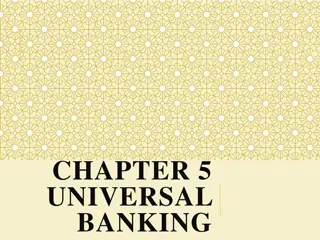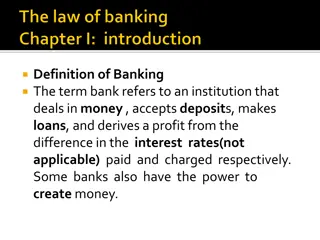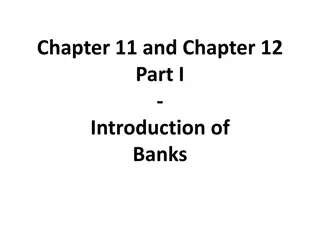Understanding Banking Institutions and Their Types
Banking institutions play a vital role in the financial sector by mobilizing public savings and providing funds to meet various financial needs. Commercial banks, investment banks, co-operative banks, and central banks are some examples of banking institutions. Scheduled banks enjoy certain benefits and are regulated by the RBI. Explore the functions, classifications, and benefits of different types of banking institutions in this informative piece.
Download Presentation

Please find below an Image/Link to download the presentation.
The content on the website is provided AS IS for your information and personal use only. It may not be sold, licensed, or shared on other websites without obtaining consent from the author. Download presentation by click this link. If you encounter any issues during the download, it is possible that the publisher has removed the file from their server.
E N D
Presentation Transcript
BANKING INSTITUTIONS According to the Banking Regulations Act, a banking institution is an institution that does the business of banking. The term banking business is defined as the accepting of deposits of money from the public for the purpose of lending or investment and repayable on demand. A banking institution mobilizes the savings of the public through accepting of deposits of money and lends the same to the individual and corporate customers to meet their short term, medium term and long term financial requirements and invests the surplus amount in various securities or financial instruments in the financial market.
TYPES OF BANKING INSTITUTIONS On the basis of the functions performed by the banking institutions, they are classified into the following types: a) Commercial Banks b) Investment Banks / Industrial Banks c) Exchange Banks d) Co-operative Banks e) Land Development Banks f) Regional Rural Banks g) Savings Banks h) Central Bank
COMMERCIAL BANKS The banks which engage in the activity of providing finance to various commercial establishments for meeting their working capital requirements are called as commercial banks. The term working capital requirement refers to the funds required for meeting the day to day activities like buying of raw materials, payment of salaries, etc. These banks raise the required funds in the form various kinds of deposits from the public and lend short term and medium term loans to traders and business persons mainly for meeting working capital requirements. The commercial banks are classified into two types viz., scheduled banks and non-scheduled banks.
Scheduled Banks - The banks which are registered in the second schedule of the RBI are called as scheduled banks. In order to be registered under the second schedule of the RBI, the following conditions should be fulfilled: 1. The bank must be carrying the business of banking in India 2. The bank must have a paid up capital and reserve of an aggregate value of not less than Rs. 5 lakhs and 3. The bank must satisfy the RBI that its affairs are not being conducted in a manner detrimental to the interests of the depositor. Non-scheduled Banks The banks which are not registered in the second schedule of the RBI are called as non-scheduled banks.
BENEFITS ENJOYED BY SCHEDULED BANKS The scheduled banks come under the direct purview of the credit control measures of the RBI and are entitled to borrowings and rediscounting facilities. Non-scheduled banks are not entitled to such benefits.
INDUSTRIAL BANKS / INVESTMENT BANKS The banks which engage in the activity of providing finance to industrialists for meeting their fixed capital requirements are called as industrial banks. The term fixed capital requirement refers to the funds required for purchasing fixed assets like Land, Building, Plant, Machinery, Furniture, etc. These banks raise the required funds in the form of issue of shares, debentures and bonds to the public and various financial institutions and lend medium term and long term loans to industrialists & big businessmen mainly for meeting their fixed capital requirements.
EXCHANGE BANKS The banks which engage in foreign exchange business are called as exchange banks. The term foreign exchange business refers to the business of converting domestic currency into foreign currency and vice-versa. These banks convert foreign currency into Indian currency and Indian currency into foreign currency and play a significant role in import and export activities.
CO-OPERATIVE BANKS The banks which are formed on the principle of mutual co-operation to meet the needs of its members are called as co-operative banks. They are formed by small group of individuals belonging to same or similar kind of activities like farming, retailing, small scale industry, etc. These banks raise the required funds in the form of various kinds of deposits from the members and the public. They lend short term and medium term loans to members and other traders, business persons and agriculturists mainly for meeting working capital requirements at generally low rate of interest and play a significant role in financing agricultural and allied activities in India.
LAND DEVELOPMENT BANKS The banks which are formed by the agriculturists on the principle of mutual co- operation to meet the long term needs of agriculturists are called as land development banks. These banks raise the required funds by the issue of shares and debentures, bonds, etc., mainly to the specific group of persons and other financial institutions. They provide short term and medium term loans to members and other agriculturists mainly for procuring tools and equipments needed and also to make permanent improvement of the land and for allied activities like cattle farming, etc., at generally low rate of interest and play a significant role in financing agricultural and allied activities in India. These banks are now-a-days called as Agriculture and Rural Development Banks.
REGIONAL RURAL BANKS The banks which are formed to mobilize the savings of the rural people and fulfill the credit needs of the relatively less served or not served sections of the societies in rural areas are called as Regional Rural Banks (RRBs). They are the banks that were set up as government sponsored regional based rural banking institutions under the Regional Rural Banks Act, 1976. The shareholding pattern of these banks is 50 : 35 : 15 among central government, sponsoring bank and state government respectively. They were configured as hybrid micro banking institutions, combining the local orientation and small scale lending culture of the cooperatives and the business culture of commercial banks. Small farmers, agricultural labourers and socio-economically weaker sections of the society are the main customers of these banks.
SAVINGS BANKS The banks which are formed to mobilize savings of the poor and middle income people of the society are called as savings banks. The primary objective of these banks is to promote the habit of thrift and savings among the people with small incomes. The money saved in these banks is permitted to be withdrawn by the depositors in time of need. However, there are certain restrictions on the number and the amount of withdrawal to be made in a particular period. In India, the central government runs savings bank through the postal department. Almost all of the commercial banks also do the function of savings bank and encourage people to open savings account with them. Generally, these banks do not engage in the activity of lending money to the public.
CENTRAL BANK The bank formed for supervising, controlling and regulating the activities of both banking and other non banking financial institutions is called as central bank. Generally, every country will have only one central bank. In India, Reserve Bank of India is the central bank. The central bank acts as a leader of the money market, enforces monetary discipline in the economy of the country, manages the issue and circulation of the currency, controls the creation of bank deposits and safe guards the financial stability of the country. It also keeps a close touch with the government and assists in the implementation of its economic policies. It serves as banker, agent and advisor to the government. Thus, it functions as the apex bank of the country and contributes to the better maintenance of the monetary and economic stability of the country. It accepts deposits from the government, banks and other financial institutions and lends the same to the government, banks and other financial institutions to enable them balance their funds position.
FOLLOWING LIST SHOWS THE MAIN FUNCTIONS OF CENTRAL BANK Main functions of central bank The functions of central bank are classified into three viz., Traditional functions, Promotional functions and Supervisory functions.
TRADITIONAL FUNCTIONS a) Monopoly of note issue b) Banker to government c) Agent and advisor to government d) Banker to banks e) Act as national clearing house f) Lender of last resort g) Controller of credit h) Foreign exchange management i) Exchange control j) Publication of information
PROMOTIONAL FUNCTIONS a) Promotion of banking habits b) Provide refinance for export promotion c) Provide facilities for agricultural activities d) Provide facilities for small scale industries e) Provide help to co-operative sector
SUPERVISORY FUNCTIONS a) Granting of license to banks b) Supervising and inspecting the activities of financial institutions c) Implementing of deposit insurance scheme d) Controlling of financial institutions























